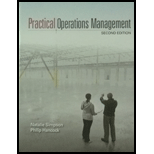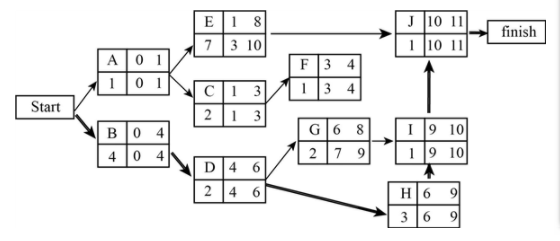
Concept explainers
a
Interpretation:
Critical path of this network.
Concept Introduction: The critical path is the arrangement of project activities which gives an estimated time duration under which the project will be completed. The project activities may include float activities which can be delayed focusing on the shortest time duration.
a
Explanation of Solution
Project network diagram for given information:
The below image shows the project network with the early start, early finish, late start and late finish:

The critical path in the project network:
The paths in the given project network are as follows:
A-E-J
A-C-F
B-D-G-I-J
B-D-H-I-J
There are four paths in the project network.
Out of the above mentioned path, the path that has the equal early start and late start at the same time early finish and late finish are the critical path.
Here two paths are satisfying the above condition, which are as follows:
A-C-F
B-D-H-I-J
When the network has more than one critical path, the path, which has the maximum project completion time, should be selected.
Hence, the critical path is B-D-H-I-J.
b
Interpretation:
Completion time of the project.
Concept Introduction: Early start time: The rule for the early start time of a task is that it is equal to the largest early finish time of the task’s immediate predecessors.
Early finish time: The early finish time of a task is the addition of both task time and early start time of the task.
b
Explanation of Solution
When the network has more than one critical path, the path, which has the maximum project completion time, should be selected.
A-C-F
B-D-H-I-J
Hence, the critical path is B-D-H-I-J.
As the critical path is determined as B-D-H-I-J, the project completion time is 11 days.
c
Interpretation:
The slack of activity A.
Concept Introduction: The critical path is the arrangement of project activities which gives an estimated time duration under which the project will be completed. The project activities may include float activities which can be delayed focusing on the shortest time duration.
c
Explanation of Solution
The slack of the activity is calculated by subtracting the early start from the late finish.
Hence, the slack of activity A is 0.
d
Interpretation:
Task to be crashed and its cost.
Concept Introduction: The critical path is the arrangement of project activities which gives an estimated time duration under which the project will be completed. The project activities may include float activities which can be delayed focusing on the shortest time duration.
d
Explanation of Solution
The cost of crashing.
It is given that the paths should be crashed and the total time of the path should not exceed 8 days. The cost to crash Activity B is $500 per crash, Activity H is $200 per crash, and all eligible activities are $100 per crash.
Use the following steps to crash the activities:
The paths and the total task time to complete the path within 8 days is shown below:
Path A-E-J:
Total task time is calculated by adding the duration of all the activities in the path.
Hence, the total task time is 9 days. It exceeds 8 days. Thus, the path should be crashed. Activity A and Activity J cannot be crashed as the duration is 1. Activity E should be crashed from 7 days to 6 days.
Hence, the total task time is 4 days. It does not exceed 8 days. Thus, the path cannot be crashed.
Path B-D-G-I-J:
Total task time is calculated by adding the duration of all activities in the path.
Hence, the total task time is 10 days. It exceeds 8 days. Thus, the path should be crashed. However, it costs $500 to crash one day of Activity B. Thus, Activity D and Activity G can be crashed from 2 days to 1 day.
The cost for crashing is $200 as the crashing was done for two days in Activity D and Activity G. It is given that the activities except for Activity B and H cost $100 per day.
Path B-D-H-I-J
Total task time is calculated by adding the duration of all the activities in the path.
Hence, the total task time is 10 days. It exceeds 8 days. Thus, the path should be crashed. Activity I, Activity D (crashed in the previous step), Activity J cannot be crashed as the duration is 1 day. Activity B can be crashed. However, it costs $500 to crash one day of Activity B. Thus, Activity H can be crashed from 3 days to 2 days.
The cost for crashing is $400 as the crashing was done for two days in Activity H. It is given Activity H costs $100 per day.
Total crashing cost:
Total crashing cost is calculated by adding all the crashing cost done in the previous steps.
Want to see more full solutions like this?
Chapter 7 Solutions
Practical Operations Management
- Agree or disagree with the post When you get an insulting offer, the best thing to do is stay calm and professional. Try not to take it personally or react out of anger. Instead, ask questions to understand why the offer was so low. This helps you get a better idea of what the other person is thinking. After that, you can respond with a counteroffer that shows your value. Use simple facts like your skills, experience, and what others in your field are getting paid to back up your request. If the person still refuses to offer something fair, it’s okay to politely say no and walk away. Standing up for yourself in a respectful way shows confidence and helps others take you seriously. Agree or disagree with the postarrow_forwardRegarding perceptions that can occur when negotiating in different places and at different times, the continuation norm in e-negotiations is best described as _____. Group of answer choices A. negotiators' beliefs that negotiations are worth continuing B. the act of thinking about how things might have turned out differently C. the tendency for e-communicators to ascribe diabolical intentions to the other party D. the tendency for negotiators to behave as if they are communicating synchronously when in fact they are notarrow_forwardIn any discussion or meeting, there is a tendency for a minority of people to do most of the talking. A key determinant of who dominates the conversation is _____. Group of answer choices A. their status within the group B. their network of social connections C. their gender D. their agearrow_forward
- With regard to intergenerational negotiation, the _____ generation has vast numbers of relationships but few of them are deep. They spend more time communicating virtually than face-to-face. Their personal and work networks are vital to their on-the-fly learning and problem-solving skills. Armed with tools for working anywhere at any time, this generation puts more value in leading a balanced life and flexibility with their work and life demands. Group of answer choices A. mature B. boomer C. millennial D. Generation Xarrow_forwardIf a negotiator has less power than the counterparty and an unattractive BATNA, which communication medium might help the less-powerful negotiator claim more resources?arrow_forwardCould you help explain what the foundations of faith are? What are their strategies?arrow_forward
- Hi! Can you guys help me with this? Thank you! Please write-up summarizing the core message of the movie/documentary and the connection to the course material The documentary is Poisoned: The Dirty Truth About Your Food directed by Stephanie Soechtig from Netflix. * Here are the course material: Global Logistics Global Transportation; Global Inventory Management Global Operation Global Market Channels Purchasing Stategies: Outsourcing; Offshoring; Nearshoring; Multi-sourcing & Co-sourcing Make or Buy decisions Global Supply Chain Infrastructure: Transportation Infrastructure; Communication Infrastructure; Utilities Infrastructure; Technology Infrastructure Supply Chain Risks: • Supply Risks – disruption of supply, inventory and schedules. • Operational Risks – breakdown of operations, changes in technologies. • Demand Risks – variations in demand.• Security Risks – theft, sabotage, terrorism, counterfeiting.• Macro Risks – economic shifts, recession, wage hikes, varying…arrow_forwardHi! Can you guys help me with this? Thank you! Please write-up summarizing the core message of the movie/documentary and the connection to the course material The documentary is American Factory by Steven Bognar & Julia Reichert from Netflix * Here the course material: Global Logistics Global Transportation; Global Inventory Management Global Operation Global Market Channels Purchasing Stategies: Outsourcing; Offshoring; Nearshoring; Multi-sourcing & Co-sourcing Make or Buy decsions Global Supply Chain Infrastructure: Transportation Infrastructure; Communication Infrastructure; Utilities Infrastructure; Technology Infrastructure Supply Chain Risks: • Supply Risks – disruption of supply, inventory and schedules. • Operational Risks – breakdown of operations, changes in technologies. • Demand Risks – variations in demand.• Security Risks – theft, sabotage, terrorism, counterfeiting.• Macro Risks – economic shifts, recession, wage hikes, varying exchangerates.• Policy Risks –…arrow_forward1) View the video Alton Bridge (12.16 mins, Ctrl + Click on the link), and please answer the following questions: https://meida.gaspar.mheducation.com/GASPARPlayer/play.html?id=24qHEm8aNZExFciJtZQbqli a) According to the video, what are the various steps involved in managing projects? b) What were the different phases of the Alton Bridge project? c) What are the two widely used scheduling techniques, and under what phase of the Alton Bridge project are they discussed? Note: As a rough guideline, please try to keep the written submission to a paragraph or so for each of the questions. 2) The following is a table of activities associated with a mining project at Lunar Industries, their durations, and what activities each must precede: Activity Duration (weeks) Precedes A (start) 1 B, C B 1 E C 4 F E 2 F F (end) 2 - The AOM project diagram is as given below: a) What is the critical path (list all activities in the…arrow_forward
- 1) View the video Alton Bridge (12.16 mins, Ctrl + Click on the link), and please answer the following questions: a) According to the video, what are the various steps involved in managing projects? b) What were the different phases of the Alton Bridge project? c) What are the two widely used scheduling techniques, and under what phase of the Alton Bridge project are they discussed? Note: As a rough guideline, please try to keep the written submission to a paragraph or so for each of the questions. 2) The following is a table of activities associated with a mining project at Lunar Industries, their durations, and what activities each must precede: Activity Duration (weeks) Precedes A (start) 1 B, C B 1 E C 4 F E 2 F F (end) 2 - The AOM project diagram is as given below:arrow_forwardWith all the problems companies are currently facing, why do so many choose to expand into international markets? What are the advantages of expanding beyond the domestic market?arrow_forwardPerform resource leveling. Assume that each task can be performed independently of the other tasks.arrow_forward
 Practical Management ScienceOperations ManagementISBN:9781337406659Author:WINSTON, Wayne L.Publisher:Cengage,
Practical Management ScienceOperations ManagementISBN:9781337406659Author:WINSTON, Wayne L.Publisher:Cengage,


